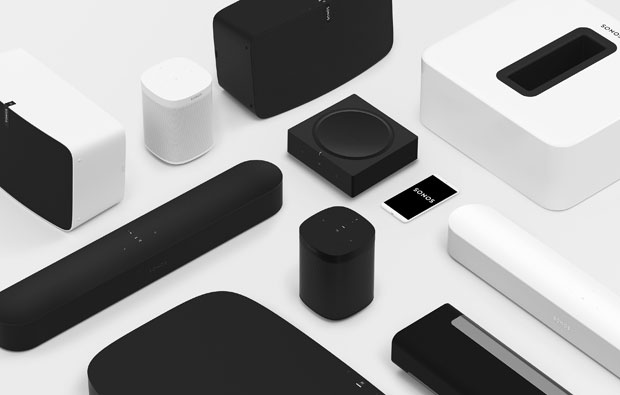Getting Sonos’ top-shelf speakers to play nice with other connected devices in the home has been challenging in the past, but that’s about to change.
The company has announced the Sonos Sound Platform, which includes new APIs, developer tools, and documentation to make it easier for Sonos products to operate with third-party hardware and software.
Sonos also announced integration with IFTTT, a free Web-based service used to integrate smart home products.
“Now you can have Sonos start your favorite radio station when your Ring-enabled door unlocks after you get home, or play your special pizza song (you do have a special pizza song, don’t you?) when your Domino’s order goes out for delivery,” Sonos community manager Ryan S wrote in an online post last week.
“IFTTT support adds a way for Sonos to tie its offerings into wider smart home integrations by drawing on end-user enthusiasm and a wider developer community,” noted Jonathan Collins, research director at ABI Research, a technology advisory company based in Oyster Bay, N.Y.
“The step is important, as it brings Sonos into the fastest-growing segment of the smart home market and increases its value to smart homes with off-the-shelf consumer devices,” he told TechNewsWorld.
New APIs, SDKs
The Sonos Sound Platform has three objectives, noted James Senior, the company’s director of product, platform, and partnerships.
- Create opportunities for Sonos partners to take advantage of growing trends in the home audio market, such as streaming music services, digital voice assistants, and smart home devices.
- Make Sonos products more approachable for developers with new APIs, SDKs, and documentation.
- Provide customers with more personalized experiences through the addition of more intelligence to the platform and with confidence in products that say they work with Sonos by creating a “Works with Sonos” certification program.
Sonos next month will add APIs that permit the playing of short, discrete sounds and notifications on a player without fully interrupting the music, Senior said, as well as allow the playing of Sonos playlists through a third-party interface and add max volume and volume pass-through controls.
More Attractive Platform
Sonos historically has been highly proprietary, as was most of the early Internet of Things industry, observed Rob Enderle, principal analyst at the Enderle Group, an advisory services firm in Bend, Oregon.
“That means that getting a connected device to work with something that didn’t come from the same vendor was just short of impossible,” he told TechNewsWorld.
“By supporting IFTTT, they move, along with others, to become a far more effective interoperable player,” said Enderle, who owns a Sonos system. “It makes the Sonos platform far more attractive, and Sonos customers far more likely to stay with the platform long term.”
The Sonos Sound Platform allows the company not only to serve its installed base better but also broaden its product portfolio, making its brand more attractive to high-end customers, said Brad Russell, an audio analyst at Dallas-based Parks Associates, a market research and consulting company specializing in consumer technology products.
Change in Attitude
By opening up its platform, Sonos has sent a signal to the market that it’s adaptable, Russell noted.
“For a long time, they fought off competition by saying, ‘We’re better because we’re proprietary. We don’t need to play with everybody else because we’re the best,” he told TechNewsWorld.
“That argument crumbles in the face of interoperable ecosystems systems of products,” Russell continued. “They’ve shifted in some positive ways for the company by moving away from that proprietary system and toward integrating with as many people as possible.”
The move also signals a change in emphasis by the company from hardware to software.
“No one just wants to be in the hardware business,” Russell said.
“Everybody wants to add value where they can, and after 15 years in the market, Sonos’ real value is in their software,” he maintained.
“In the long term, Sonos wants to create value in software applications and the integration platform, not just the hardware,” said Paul Erickson, senior research analyst at the Austin, Texas, offices of IHS Markit.
Deepening the Moat
Opening up the Sonos platform allows it to stay ahead of its competition, Erickson explained.
“It will help differentiate them in a market where the core functionality of having WiFi-connected speakers and multiroom audio is becoming commoditized,” he told TechNewsWorld.
“The core capabilities that they had three or four years ago are no longer unique — they’re in every smart speaker today,” Erickson pointed out.
“It will put a deeper moat around the territory they already have a hold on more than growing new markets,” he added.
The program also could attract more developers to the Sonos ecosystem.
“Ideally, third parties will build apps that add valuable new functions and service capabilities into Sonos smart speakers and increase their usability and customer satisfaction,” said Charles King, a Hayward, California-based principal analyst with Pund-IT, a technology advisory firm.
“It’s analogous to taking a simple pocket knife and, with the help of developers, giving it the cool new capabilities of a Swiss Army Knife,” he told TechNewsWorld.
While removing one of the major barriers to participation should help attract developers, “developers will still need to see a strong value proposition to justify their investment,” Enderle noted. “Still, without interoperability, there was no real reason even to consider Sonos as a platform.”
Better Market Position
Sonos’ new open approach could impact its fortunes in the home speaker market, which Parks Associates expects to take off in the coming months.
“We’re expecting to see a really huge sales jump in Q3 and Q4 this year,” said Kristen Hanich, research analyst at Parks Associates.
“Certainly, a more capable Sonos One device will help drive sales,” she told TechNewsWorld.
There’s a perception that smart speakers are ground zero for creating and evolving smart home solutions and services, King noted.
“If that’s the case, efforts like Sonos’ partnership with IFTTT should help the company stay in the thick of things as the smart home market develops and evolves,” he suggested.
“This open API positions Sonos to much more effectively compete with big guys like Apple, Amazon, and Google,” Russell added, “even while not trying to do everything they do.”























































